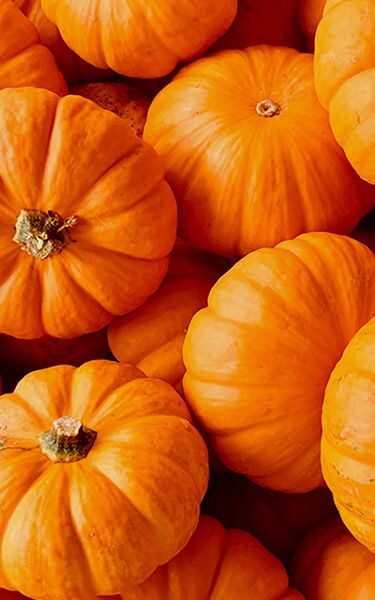Pumpkin, a variety of winter squash, is a member of the gourd family and comes in a variety of sizes, shapes, and colors. The fruit grows on vines and is ready to be harvested in early autumn. Orange-skinned, round pumpkins are the most familiar varieties that fill the pumpkin patches. This variety is better for carving and decoration rather than eating. Pie pumpkins and sugar pumpkins are the best choices for cooking.
The smaller pumpkins are sweeter than the larger carving pumpkins. The flesh is mildly sweet. It gets softer, nuttier and caramelized when roasted. It’s similar in flavor to a sweet potato but with more pronounced squash notes.
Storage
Store whole pumpkins in a cool, dry, and dark place. Thoroughly wash and dry the pumpkin after bringing it home. Rather than placing pumpkins directly on cement in your garage or in your basement, place a piece of cardboard or wood underneath to avoid premature spoilage. Avoid picking up or carrying a pumpkin by its stem. In the case of the stem breaking off, the resulting exposed flesh may begin to rot. In general, you can store a pumpkin for one to three months. If you wanna learn more about how to store vegetables in your fresh, check out this article!
Buying Pumpkins
During the autumn months, pumpkins can be easily found at grocery stores. Procuring them from a pumpkin patch, a farmers market, a roadside produce stand or simply growing your own will result in the freshest pumpkins. Just be sure that the fruit stays on the vine as long as possible. When selecting pumpkins for cooking, look for small fruits between four and eight pounds that are blemish-free. There should not be any soft spots and the pumpkin should feel heavier than it looks.
Growing Pumpkins
Pick a day after the last frost to sow seeds directly in the ground. Each seed packet will list how long on average the plant needs to produce full-grown pumpkins (“Days for Maturity”). For example, Small Sugar Pumpkins need 100 days to reach maturity. If you wanted them to ripen about a week before Halloween, then plan on planting them in mid-July.
Getting the most out of your pumpkin leftovers
Whether it becomes a tasty snack or a creative project, your pumpkin can continue bringing you joy even after Halloween.
Consuming your pumpkin leftovers is probably the most enjoyable way to put them to good use.
Also, did you know that you can use pumpkin in your latte or espresso?
Halloween might be over, but it’s still fall and pumpkins make great additions to your home, garden, and holiday decorations. Keep the fall festivities going by using your pumpkin as a planter for a small potted plant. The planter will last for several weeks, and then you can plant it directly in your garden to decompose. Check out our article to learn more
Share



